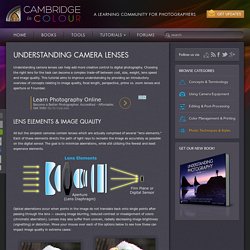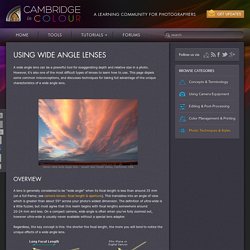

Sigma 18-250. Understanding Camera Lenses. Understanding camera lenses can help add more creative control to digital photography.

Choosing the right lens for the task can become a complex trade-off between cost, size, weight, lens speed and image quality. This tutorial aims to improve understanding by providing an introductory overview of concepts relating to image quality, focal length, perspective, prime vs. zoom lenses and aperture or f-number. All but the simplest cameras contain lenses which are actually comprised of several "lens elements. " Each of these elements directs the path of light rays to recreate the image as accurately as possible on the digital sensor. The goal is to minimize aberrations, while still utilizing the fewest and least expensive elements.
Using Wide Angle Lenses. A wide angle lens can be a powerful tool for exaggerating depth and relative size in a photo.

However, it's also one of the most difficult types of lenses to learn how to use. This page dispels some common misconceptions, and discusses techniques for taking full advantage of the unique characteristics of a wide angle lens. 16mm ultra-wide angle lens - sunset near Death Valley, California, USA A lens is generally considered to be "wide angle" when its focal length is less than around 35 mm (on a full frame; see camera lenses: focal length & aperture).
SAL-20F28 20mm f/2.8 Wide-Angle Lens.